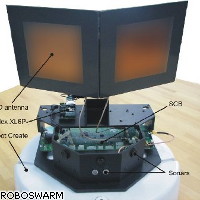Estonians put ROBOSWARM technology to the test
Invent Baltics, an Estonian research and development (R&D) consultancy group, has successfully tested the swarm coordination technology demonstrator that was designed and developed by the EU-funded ROBOSWARM ('Knowledge environment for interacting robot swarms') project. ROBOSWARM received almost EUR 1.7 million under the 'Information society technologies' Thematic area of the Sixth Framework Programme (FP6). Launched in 2006 and finalised in 2009, ROBOSWARM targeted the development of a technology for self-configurable, inexpensive and robust robot swarms that people could use in various applications on a daily basis including, among others, cleaning, patrolling and escorting. A robot swarm is similar to a colony of ants: with a higher collective intelligence, the swarm may be used to accomplish tasks that lie beyond the capabilities of a single robot. Bringing together 9 research and industry partners from 7 countries, ROBOSWARM fulfilled its goal of developing a demonstrator that is composed of 10 to 15 devices and that allows a swarm of simple robots to perform a number of cleaning tasks. The project partners used fixed RFID (radio frequency identification) tags to help the swarms with positioning and navigation. The tags are used by the robots for coordination and task sharing, and are marked with various surfaces and objects. Thanks to the ROBOSWARM technology, simple robots will be able to communicate extensively so as to split individual tasks in order to heighten the functionality of the swarm (i.e. scalability), to learn from the experience of individual swarm members through the local or international knowledge base (i.e. self-learning), and to operate with as few sensing capabilities as possible (i.e. cost efficiency). Experts say there is a growing interest in the multi-robot system (MRS) where several robots interact to achieve common goals; the potential to perform coordinated tasks compared to a single robot system effectively save time, money and effort. Microsoft Research in the US has already expressed an interest in the ROBOSWARM technology. ROBOSWARM is coordinated by the Department of Computer Science at Tallinn University of Technology in Estonia, and brings together teams from Estonia, Spain, France, Italy, Portugal, Finland and Sweden.
Countries
Estonia



